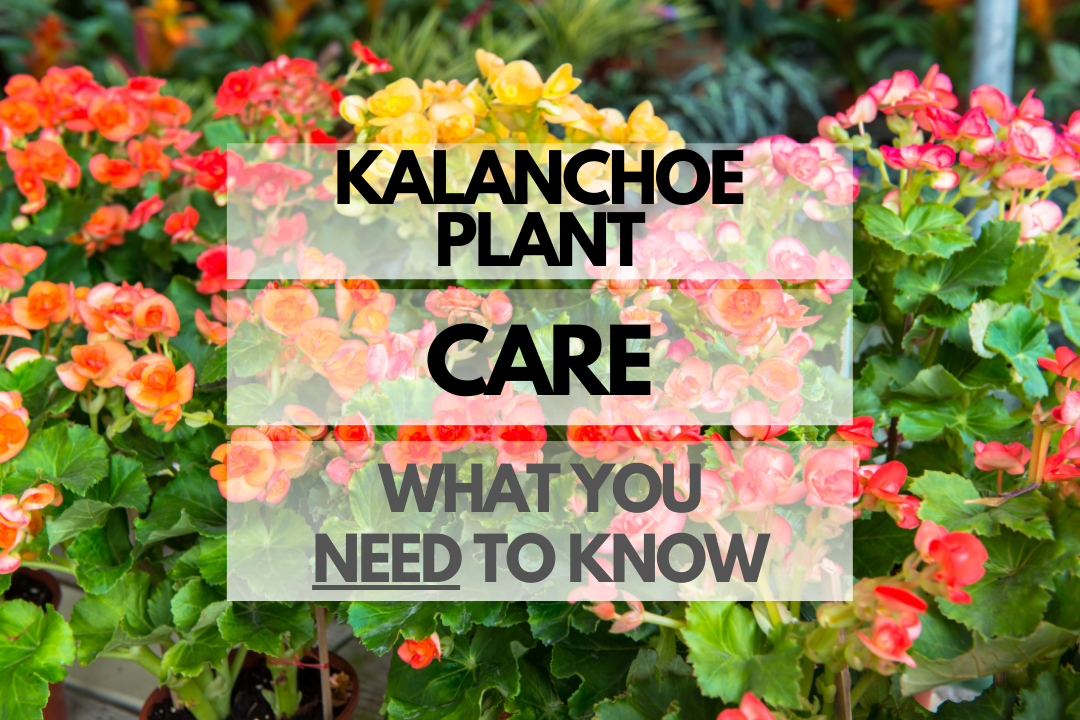If you’re looking for a vibrant, low-maintenance houseplant that adds a pop of color to your space, look no further than the Kalanchoe Plant! In this article, we’ll cover everything you need to know about Kalanchoe Plant care, including sunlight, soil, watering, pruning, and more. Let’s dive in!
Kalanchoe Plant Care Guide
Quick Reference Table: Caring for Kalanchoe Plant
| Aspect | Details |
|---|---|
| Sunlight | Bright, indirect light (4-6 hours per day) |
| Soil | Well-draining cactus or succulent mix |
| Watering | Allow top inch of soil to dry between waterings |
| Pruning | Remove dead or yellowing leaves, pinch back leggy growth |
| Temperature | 60-75°F (15-24°C) |
Kalanchoe Plant Sunlight: Do They Need It and How Much?
Kalanchoe Plants thrive in bright, indirect sunlight. They need around 4-6 hours of sunlight per day to grow and maintain their vibrant foliage. Be cautious of direct sunlight, which can scorch the leaves and cause them to turn yellow or brown.
Kalanchoe Plant Soil Tips
When it comes to soil, Kalanchoe Plants prefer a well-draining cactus or succulent mix. This type of soil ensures that excess moisture can escape easily, preventing root rot. You can add perlite or coarse sand to your potting mix to improve drainage if necessary.
Kalanchoe Plant Watering and Frequency
As a succulent, Kalanchoe Plants store water in their leaves, which means they can go longer between waterings. Allow the top inch of soil to dry out before watering again. Overwatering can lead to root rot, so it’s essential to provide the right amount of water and ensure proper drainage.
Pruning Kalanchoe Plant Properly
Pruning your Kalanchoe Plant can help maintain its shape and encourage bushier growth. Remove any dead or yellowing leaves, and pinch back leggy growth to promote branching. Prune your Kalanchoe Plant as needed throughout the year to keep it looking its best.
Optimal Kalanchoe Plant Temperature: Can They Tolerate the Cold?
Kalanchoe Plants prefer temperatures between 60-75°F (15-24°C). They cannot tolerate cold temperatures and should be protected from frost and drafts. If you live in a colder climate, it’s best to keep your Kalanchoe Plant indoors during the winter months.
Common Kalanchoe Plant Problems
Overwatering
Overwatering is a common issue with Kalanchoe Plants. Symptoms include yellowing leaves, soft and mushy stems, and root rot. To avoid overwatering, allow the top inch of soil to dry out before watering, and ensure your pot has proper drainage.
Pests
Kalanchoe Plants can be susceptible to pests such as mealybugs, spider mites, and aphids. To prevent and treat infestations, keep your plant clean, provide proper care, and use insecticidal soap or neem oil if needed.
Leaf Drop
Leaf drop can occur when a Kalanchoe Plant is exposed to cold temperatures or drafts. Make sure your plant is in a warm, draft-free area with temperatures between 60-75°F (15-24°C).
Kalanchoe Plant Outdoors vs Indoors
Kalanchoe Plants can grow both indoors and outdoors, depending on your climate and the specific care they receive. Here’s a list of pros and cons for each:
| Indoors | Outdoors |
|---|---|
| Easier to control temperature andlighting conditions | Can benefit from natural sunlight and fresh air |
| Less susceptible to pests and diseases | Can potentially grow larger and more vigorous |
| Can be enjoyed year-round | Risk of cold damage in colder climates |
Best Pots for Kalanchoe Plant
When choosing a pot for your Kalanchoe Plant, select one with drainage holes to prevent waterlogged soil and root rot. Materials like terracotta and unglazed ceramic are excellent choices because they allow excess moisture to evaporate through the pot’s walls. Make sure the pot is just slightly larger than the root ball, as a too-large pot can retain too much moisture and lead to overwatering issues.
Kalanchoe Plant Facts
Kalanchoe Plant Benefits
Kalanchoe Plants offer several benefits, which include:
- Air purification: Kalanchoe Plants can help purify indoor air by removing pollutants such as formaldehyde and benzene.
- Low maintenance: As a succulent, Kalanchoe Plants are easy to care for and require minimal attention, making them perfect for beginners or those with busy schedules.
- Vibrant colors: Their colorful and unique foliage adds a pop of color to your indoor or outdoor space.
- Long-lasting blooms: Some Kalanchoe varieties produce beautiful flowers that can last for several weeks, brightening up your home or garden.
Growth Rates: How Fast Do They Grow?
Kalanchoe Plants have a moderate growth rate and can reach their mature size within a few years. The growth rate depends on factors such as the specific species, environmental conditions, and care provided.
Kalanchoe Plant Lifespan
With proper care, Kalanchoe Plants can live for several years. Their lifespan can be extended by providing the right growing conditions, fertilizing, and repotting when necessary.
Are Kalanchoe Plants Safe?
Kalanchoe Plants are mildly toxic to pets and humans when ingested. The toxicity levels vary between species, but it is best to keep these plants out of reach of children and pets to prevent accidental ingestion.
Kalanchoe Plant Flowers
Many Kalanchoe Plant varieties produce beautiful flowers in various colors, including red, pink, orange, yellow, and white. The flowers usually appear in clusters and can last for several weeks, adding a burst of color to your space.
Kalanchoe Plant Types and Varieties
Kalanchoe blossfeldiana
Kalanchoe blossfeldiana, also known as Flaming Katy, is a popular houseplant known for its vibrant, long-lasting flowers that appear in a range of colors. The leaves are thick, dark green, and oval-shaped with scalloped edges.
Kalanchoe tomentosa
Kalanchoe tomentosa, commonly known as Panda Plant or Teddy Bear Plant, has soft, fuzzy leaves covered in tiny hairs. The leaves are grayish-green with brown spots along the edges, giving the plant a unique appearance.
Kalanchoe pumila
Kalanchoe pumila, also known as Flower Dust Plant, has small, grayish-green leaves covered in a powdery white coating. This compact, trailing plant produces clusters of pink flowers, making it a lovely addition to hanging baskets or containers.
Kalanchoe Plant Pros and Cons
| Pros | Cons |
|---|---|
| Low maintenance | Mildly toxic to pets and humans |
| Colorful foliage and flowers | Prone to overwatering |
| Air purifying | Can be susceptible to pests |
Kalanchoe Plant Cost
Kalanchoe Plants are relatively affordable, with prices typically ranging from $5 to $20, depending on the size, type, and age of the plant. Specialty varieties may cost more.
Where to Buy Kalanchoe Plants
Kalanchoe Plants can be purchased at local nurseries, garden centers, or online plant shops. Make sure to choose a reputable seller to ensure the plant’s health and quality.
Is Kalanchoe Plant Propagation in Water Possible?
Yes, Kalanchoe Plant propagation in water is possible. Simply take a healthy leaf or stem cutting, let it dry for a couple of days to allow the cut end to callous, and then place the cutting in a container of water. Make sure the water level covers only the cut end, not the leaves. Change the water regularly to keep it fresh, and roots should start to develop within a few weeks.
Additional Resources
- Gardeners’ World – A comprehensive resource for gardening tips, plant care, and inspiration.
- Succulent City – A website dedicated to all things succulents, including Kalanchoe Plant care and propagation.
- Succulent Lovers Facebook Group – A community of succulent enthusiasts sharing their knowledge, tips, and experiences.
- Kalanchoe Care for Beginners – A book dedicated to helping you successfully grow and care for your Kalanchoe Plants.
FAQ for Kalanchoe Plant Care
Are Kalanchoe Plants toxic to cats?
Yes, Kalanchoe Plants are toxic to cats when ingested. It is best to keep these plants out of reach of pets to prevent accidental ingestion.
Are Kalanchoe Plants toxic to dogs?
Yes, Kalanchoe Plants are toxic to dogs when ingested. Keep these plants away from your pets to ensure their safety.
Are Kalanchoe Plants toxic to kids?
Kalanchoe Plants are mildly toxic to humans when ingested and can cause symptoms such as vomiting and diarrhea. Make sure to keep these plants out of reach of children.
How tall do Kalanchoe Plants get?
Kalanchoe Plants can grow anywhere from 1 to 2 feet tall, depending on the species and growing conditions.
Can Kalanchoe Plants live outside?
Kalanchoe Plants can be grown outdoors in warm climates, but they are sensitive to cold temperatures and should be brought indoors or protected during the winter months in colder regions.
Are Kalanchoe Plants poisonous?
Kalanchoe Plants are mildly poisonous when ingested, causing symptoms such as vomiting and diarrhea in humans and pets. Keep these plants out of reach to prevent accidental ingestion.

